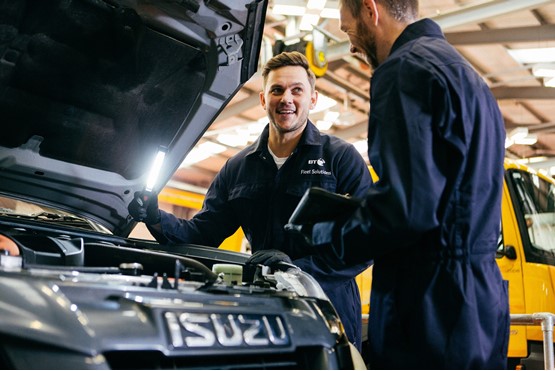Despite Brexit, vans of 2.5 tonnes-plus may still have to comply with EU rules, especially when deliveries take them across the border. By Steve Banner
Vans could come within the scope of operators’ licensing (O-licensing) thanks to legislative changes under discussion in Europe; but only certain types of operation would be affected.
It stems from a European Commission proposal to amend two sets of regulations – EC 1071/2009 and EC 1072/2009 – as part of what it refers to as the Mobility Package.
Assuming the proposal goes through, this means that businesses operating vans grossing at 2.5 tonnes and above on international hire and reward work will have to hold an O-licence and comply with its requirements.
That would, among other things, include the installation of a tachograph and obeying the Drivers Hours rules.
On the face of it, the number of UK-based light commercials likely to be affected is comparatively small. Where it could have an impact, though, is on cross-border traffic between Northern Ireland and the Republic.
“It’s come about as the consequence of hauliers in Western Europe becoming increasingly annoyed by operators from Eastern Europe trying to compete with them with vehicles that, in theory, are 3.5 tonners but, in practice, may be running at a rather higher weight,” says James Firth, head of road freight regulation policy at the Freight Transport Association (FTA).
If the regulatory change does come into force then it may not be until after the UK’s planned departure from the European Union next March.
British operators could still be affected after that date, however, because, should they cross into EU territory, European enforcement officials may require them to show evidence that they are O-licence holders.
“Those officials may, of course, then find themselves having to determine whether the goods in the back of a van belong to the van’s owner or are being transported on behalf of a third party,” Firth says.
“While they are sifting through the paperwork, they will not be doing what they should really be doing, which is checking the vehicle’s roadworthiness and weighing it to ensure that it is not over-loaded.”
Regardless of the EC’s proposal, there is an argument in favour of extending the O-licence regime within the UK down to three tonnes in order to encompass light commercials grossing at from three to 3.5 tonnes and subject to Class 7 MOT tests.
MOT failure rates

According to the most recent figures from the Driver and Vehicle Standards Agency (DVSA), 45.4% of all 3.0-to 3.5-tonners presented for their MOT test in 2016/17 failed, with a final fail rate of 35.9%. Both figures are significantly higher than those for any other category of vehicle.
There has been a significant expansion of the 3.5-tonne parc in the wake of the rise of online shopping and home delivery along with anecdotal evidence that 3.5t vans are increasingly being used to handle work hitherto undertaken by 7.5t trucks.
Anyone with a car licence can drive the former. Drive the latter and you have to take and pass a separate test unless you can claim so-called ‘grandfather’ rights.
You have to hold a driver Certificate of Professional Competence too and 7.5-tonners are subject to O-licensing.
Firth doubts that subjecting Class 7 vehicles and their operators to the rigours of the O-licence would solve the test failure problem even though annual pass rates for HGVs are around 80%, with final fail rates below 10%.
“It is something we would be opposed to,” Firth says.
Extending the remit of O-licensing to light commercials and ensuring that the undertakings operators have to give in respect of maintenance and the Drivers Hours rules are enforced would be a mammoth task for the DVSA given the number of vehicles that would be involved, he points out.
Enforcement could end up being so inadequate that less-scrupulous businesses running vans might be tempted to ignore the rules entirely because they know they would be unlikely to be caught.
“Always remember that there are people who will do what the law says and those who will see what they can get away with and that, for enforcement to be credible, it must be effective,” Firth says.
“Companies must know that if they do not meet the standards laid down then something will happen to them.”
Vans can be stopped at the roadside, anyway, if they are clearly overloaded or in an un-roadworthy state and the FTA would prefer to see tougher action in this area before any extension of the O-licence is contemplated.
The Society of Motor Manufacturers and Traders (SMMT) says that out of the almost 11,000 vans stopped at the roadside annually, more than 60% have serious mechanical defects and almost 90% are overloaded.
The number stopped is a fraction of a percentage of the four million-plus light commercials on UK highways.
Van Excellence scheme
A more-sensible approach than expanding O-licensing’s remit, Firth suggests, would be to encourage light commercial fleets to raise their own standards through initiatives such as Van Excellence and FORS.
“Every Van Excellence member has made a commitment to aspire to be the very best in the industry,” says FTA head of vans, Mark Cartwright.
“And with an increasing number of vans on the UK’s streets, all road users benefit from improved standards of van driving and maintenance.”
Firth’s view is shared by Alison Bell, marketing director at fleet management company Venson Automotive Solutions, who says: “Self-regulation is the best way to go.”
In her view it would deliver many of the benefits that could flow from an extension of O-licensing, but without resulting in additional bureaucracy.
Responsible for some 5,500 light commercials, Venson has been helping FTA to deliver a series of short courses for van fleet managers under the Certificate of Excellence banner.
Held at a variety of locations around the country, including operators’ premises, and delivered by an FTA trainer, they address topics such as safe and legal loading, maintenance, speed limits and driver licensing.
They are free and attendees receive a certificate valid for three years once the course is completed, says Bell. As well as raising standards, a key aim of the courses is to prompt greater interest in Van Excellence among fleets that have yet to engage with it.
“Typically, each course has from six-to-16 delegates and many of them are from local government, housing associations and public utilities,” she says. “So far as the private sector is concerned we tend to see quite a few people from facilities management companies.”
In other words, they are organisations who require vans but – unlike parcels companies – do not view running them as one of their core activities.
As a business that provides fleet management services, Venson believes there are a number of areas light commercial fleets need to home in on to up their game – if they are not already doing so.
Among them is the need to ensure drivers carry out heavy-truck-style daily walk-around checks on their vans before they venture out onto the public highway, ensuring, for example, that there are no suspicious bulges in tyre sidewalls or broken exterior rear view mirrors.
“Wall-around-check apps are now available for smartphones,” Bell says. A procedure must be in place to ensure any defects are rectified.
Occupational road risk also has to be addressed.
“If an accident happens then you have to ask why it occurred and whether the driver concerned has been involved in similar incidents in the past,” she says. “It’s about managing individuals as much as it is about managing vehicles.”
While BT Fleet supports any and all safety initiatives, the only thing that widening the O-licence net would achieve in practice would be to increase fleet overheads. So says Dave Edwards (below), its head of transport compliance and chair of the Van Excellence governance group.

“Legislation does not necessarily improve things,” he says, agreeing with Firth that it is questionable whether the DVSA has the resources to cope with van O-licensing.
An expanded O-licence regime would presumably mean that large numbers of light commercials would suddenly be subjected to regular statutory safety inspections, says Edwards, resulting in increased downtime and costs.
Presumably they would also have to be based at nominated operating centres. “A lot of our vans are out-based and these days we simply wouldn’t have the space to park them at our depots,” Edwards says.
Furthermore, drivers would be faced with having to travel to depots to pick up their vehicles rather than go to work straight from home. The cost of running the business would increase as a consequence, he points out; and it is the consumer who would, ultimately, foot the bill.
Then there would be the cost and complication of training van drivers to use a tachograph and comply with the Drivers Hours rules as well as ensuring that they all had the necessary digital tachograph card; and tachographs would have to be installed. “Remember that we’ve got 20,000 vans at BT Fleet,” he remarks.
More transport managers needed
Major fleets would need to recruit more transport managers to handle the entire exercise, Edwards says, pushing up salary bills.
Like Firth and Bell, he believes that allowing the industry to regulate itself makes more sense, alongside stricter enforcement of existing regulations to catch light commercial owners who behave irresponsibly.
Nor is it necessarily the builder with the old ex-council tipper who is at fault, he stresses.
He is concerned that some of the independent couriers who act as sub-contractors to the big parcels companies may be clocking up extremely high mileages without having their two-to-three-year-old ex-fleet vans serviced or ensuring regular safety checks are carried out.
“They may be the worst offenders,” he says.
Edwards agrees with Bell about the importance of daily walk-around checks.
“But they should not be treated as a box-ticking exercise,” he insists. “They need to be written into a fleet’s DNA.”
They should be backed up by spot checks on vehicles when they leave the company’s premises to ensure worn tyres and cracked windscreens have not been ignored and that there is no overloading. Managers should ensure that out-based vans are checked, too.
With almost 400 light and heavy commercial vehicles, leading LPG supplier Flogas is already an O-licence holder.
“Any lowering of the threshold probably wouldn’t have a huge impact on us – we would be able to comply – but it would mean increased administrative complexities,” says fleet manager Stephen Moir.
“It would, for example, make it more complicated to relocate vehicles from one site to another.
“It would also mean retrofitting tachographs to our light commercials, some of which may not be able to accept them. On a wider scale, lowering the threshold would potentially put a lot of people out of business,” he continues. “I’m thinking about local plumbers, gardeners and so on.”
Often self-employed, they would find it difficult if not impossible to get to grips with all the unexpected ramifications of O-licensing; not to mention the extra costs they would have to shoulder.
Their vehicles would be subject to statutory inspections, he says, and that would increase their workshop bills; a point already made by Edwards.
“It’s a change that would have a massive, negative impact and should be avoided,” Moir states. “Furthermore, it would be horrendously expensive for the Government to police it, given the number of vehicles that would be involved.”
Sufficient funding
On the question of cost, an O-licence imposes a financial standing requirement on the holder. Traffic commissioners need to be sure the business concerned has sufficient funding available to maintain its vehicles.
Standard national and international licence holders have to show that they have £7,950 available for their first vehicle and £4,400 for each of their other vehicles – figures set by the European Union.
The figures for restricted licence holders are £3,100 and £1,700 respectively and are set by the UK’s Office of the Traffic Commissioner, which had just started a consultation at the time of writing to determine whether or not they should be lifted.
They have not been increased since 2004.
It seems unlikely that financial standing requirements of a similar size would be required for vans; but even if they were set at no more than, say, £1,000 a vehicle, the burden on fleets would be substantial.
While it is difficult to establish a correlation between the two, the roll-out of Van Excellence and similar initiatives has coincided with a gradual improvement in Class 7 pass rates.
In 2013/14 the initial fail rate was 50.3% with a final fail rate of 40.9%. In 2014/15 the figures fell to 48.9% and 39.2% respectively, and to 46.8% and 37.2% in 2015/16.
The 2016/17 figures referred to earlier reveal a further decline.
Ian Hill (below), managing director of contract hire and leasing specialist Activa Contracts, agrees with Moir that bringing Class 7 vehicles under the O-licence umbrella would be less of a problem for an existing O-licence holder who is used to the regime than for those who have no experience of the system. Activa has some 1,500 light commercials on its books.

“For non-O-licence holders, though, it would be a whole new ball game,” he says.
Contract hire and fleet management companies would be on hand to provide support however, he points out.
“From their viewpoint it would be no different to what they have been doing for truck operators for many years in terms of ensuring that regular services and statutory inspections are carried out,” Hill says.
“It wouldn’t spook our industry at all.”
In one respect, O-licence thresholds are rising rather than falling. Unlike their diesel counterparts, electric- and gas-powered vans are being allowed to operate at up to 4.25 tonnes gross without an O-licence being required.
The idea is to reward businesses that have opted to run environmentally-friendly vehicles despite the fact that the additional weight of the battery packs or gas tanks that are required cuts their payload.
It will be interesting to see whether this concession continues as the number of light commercials powered by alternative fuels grows and the weight of the technology they use falls.
The situation could change if the Mobility Package referred to earlier is implemented and written into UK law. At present there are no plans to reduce the O-licence threshold, says DVSA head of enforcement policy, Gordon McDonald.
“Any initiative to change this would need to involve lengthy consultation,” he says. “The impact on operators in terms of cost, burden and proportionality would all be important factors which would need to be considered.”
That is not to say that irresponsible light commercial owners can look forward to an easy ride, he stresses.
“The DVSA’s priority is to protect the public from unsafe drivers and vehicles,” he says.
“One of the ways in which it addresses compliance issues in the light goods vehicle sector is to include these vehicles as part of its enforcement regime, which includes checking vehicles at the roadside and issuing prohibitions for roadworthiness issues where appropriate.”
O-licensing remains a weapon that a future government could wield if it is not satisfied that businesses that run light commercials are adhering to the standards expected of them.
It’s a good argument for embracing Van Excellence, FORS or other programmes with the aim of ensuring the weapon is never unsheathed.



















Don Campbell - 24/02/2020 17:16
Very interesting article. I know it's not strictly in line with Fleet News but as a camper-van user with a 3.5T LWB Ducato I'm interested in whether we will simply be swept up with whatever legislation is passed. With the furniture, two people (possibly 4), water and fuel plus extras like an awning, bike carrier, food and other bits and pieces we struggle massively to keep to the limit and I'm sure most are over on a long holiday. Is there any hope that we might see a sensible change to being able to drive a 4T vehicle on a B license without all the palaver of getting a C1?